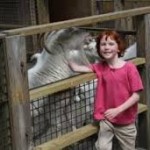 Many new parents mistakenly feel that they are home-free if their newborn and their dog get along as soon as everyone is home from the hospital. But, dog behavior experts say that’s just the first of many steps in living harmoniously with kids and canines. Each new phase of development for your child also means a new phase your dogs has to adapt to, and it’s all a work in progress.
Many new parents mistakenly feel that they are home-free if their newborn and their dog get along as soon as everyone is home from the hospital. But, dog behavior experts say that’s just the first of many steps in living harmoniously with kids and canines. Each new phase of development for your child also means a new phase your dogs has to adapt to, and it’s all a work in progress.
 Perhaps the most challenging phase? You guessed it: the toddlers years. Just as these trying times are difficult for parents, they are also puzzling and stressful for dogs. These pint-size people can be loud, silly, and temperamental, move erratically, not understand the work “no” – at least most of the time – and require constant supervision. I cannot stress enough how important this is. NEVER trust a dog alone with your infant/toddler. No matter how confident you are in the docile nature of your pet, you never know what could happen when your child is mobile. It can all be overwhelming, so don’t let down your guard when the two are together.
Perhaps the most challenging phase? You guessed it: the toddlers years. Just as these trying times are difficult for parents, they are also puzzling and stressful for dogs. These pint-size people can be loud, silly, and temperamental, move erratically, not understand the work “no” – at least most of the time – and require constant supervision. I cannot stress enough how important this is. NEVER trust a dog alone with your infant/toddler. No matter how confident you are in the docile nature of your pet, you never know what could happen when your child is mobile. It can all be overwhelming, so don’t let down your guard when the two are together.
“One of the biggest mistakes people make is that they become complacent,” says Sharon Wirant, manager of Anti-Cruelty Behavior Services for the American Society for the Prevention of Cruelty to Animals, adding that when parents stop supervising, even to just send a quick email, that’s when something happens. ” A lot can happen in a minute,” she adds.
 Don’t assume that a “nice” dog will always be calm and happy around your toddler. Owners need to learn their dog’s body language and stress signals. These include cowering, panting excessively, licking lips, shaking, looking away, leaning away, and tensing up. Growling is also a sign, but Wirant says owners should be aware of the subtler signals, so the dog doesn’t have to escalate to growling or snapping at a toddler.
Don’t assume that a “nice” dog will always be calm and happy around your toddler. Owners need to learn their dog’s body language and stress signals. These include cowering, panting excessively, licking lips, shaking, looking away, leaning away, and tensing up. Growling is also a sign, but Wirant says owners should be aware of the subtler signals, so the dog doesn’t have to escalate to growling or snapping at a toddler.
It is key for owners to understand when their dog is uncomfortable and to react before the dog feels the need to take action One way to do that is to observe interactions very closely. If you sense tension, call the kids back, and then give the dog permission to leave and go to her spot, such as a crate or a room off-limits to the kids.
” If you even think your dog looks uncomfortable, you need to give him some space,”…. When a dog is in a crate, he’s giving himself a timeout.”
 Parents can also teach their toddlers how to behave around dogs. Emphasize that children cannot hit or tackle dogs, and prevent them from doing so. Don’t allow around-the-neck hugs, teach children to offer gentle pats on the back-not on your dog’s head- and never allow them to go near your dog when she eats. Reward good behavior. Stickers and favorite food items can be high-value items for the toddler demographic, but other kinds of rewards work too.
Parents can also teach their toddlers how to behave around dogs. Emphasize that children cannot hit or tackle dogs, and prevent them from doing so. Don’t allow around-the-neck hugs, teach children to offer gentle pats on the back-not on your dog’s head- and never allow them to go near your dog when she eats. Reward good behavior. Stickers and favorite food items can be high-value items for the toddler demographic, but other kinds of rewards work too.
Guaranteeing good doggie manners is also crucial. Considering dog training a part of everyday life, one or two minutes at a time. At mealtime, put the dog on a Down-stay, or have her stay on the living room carpet and not set paw on the kitchen tile. Reinforcing boundaries like this is very helpful in managing toddlers and dogs. Carry around a bag of treats, or keep treat bags stashed throughout the house, and reward the dog for doing a quick sit-stay at the doorway of the nursery during a diaper change, or going to her crate when your young one needs a bath, for examples.
You can, throughout the day, reinforce the behavior you want.
Dr. Dawn
Please share and subscribe here



